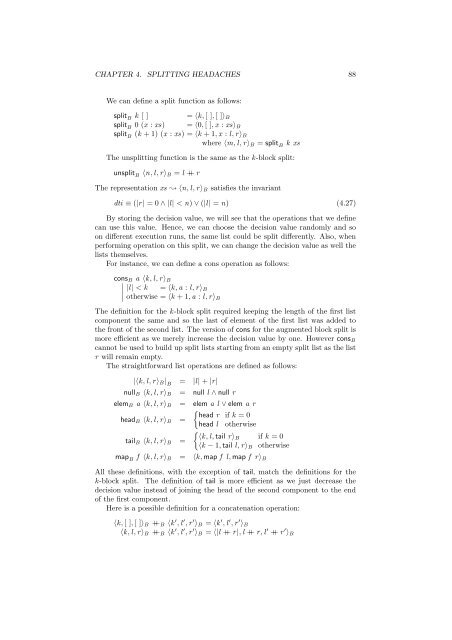Obfuscation of Abstract Data-Types - Rowan
Obfuscation of Abstract Data-Types - Rowan
Obfuscation of Abstract Data-Types - Rowan
Create successful ePaper yourself
Turn your PDF publications into a flip-book with our unique Google optimized e-Paper software.
CHAPTER 4. SPLITTING HEADACHES 88<br />
We can define a split function as follows:<br />
split B k [ ] = 〈k, [ ], [ ]〉 B<br />
split B 0 (x : xs) = 〈0, [ ],x : xs〉 B<br />
split B (k + 1) (x : xs) = 〈k + 1,x : l,r〉 B<br />
where 〈m,l,r〉 B = split B k xs<br />
The unsplitting function is the same as the k-block split:<br />
unsplit B 〈n,l,r〉 B = l + r<br />
The representation xs ❀ 〈n,l,r〉 B satisfies the invariant<br />
dti ≡ (|r| = 0 ∧ |l| < n) ∨ (|l| = n) (4.27)<br />
By storing the decision value, we will see that the operations that we define<br />
can use this value. Hence, we can choose the decision value randomly and so<br />
on different execution runs, the same list could be split differently. Also, when<br />
performing operation on this split, we can change the decision value as well the<br />
lists themselves.<br />
For instance, we can define a cons operation as follows:<br />
cons ∣ B a 〈k,l,r〉 B<br />
∣ |l| < k = 〈k,a : l,r〉 B<br />
otherwise = 〈k + 1,a : l,r〉 B<br />
The definition for the k-block split required keeping the length <strong>of</strong> the first list<br />
component the same and so the last <strong>of</strong> element <strong>of</strong> the first list was added to<br />
the front <strong>of</strong> the second list. The version <strong>of</strong> cons for the augmented block split is<br />
more efficient as we merely increase the decision value by one. However cons B<br />
cannot be used to build up split lists starting from an empty split list as the list<br />
r will remain empty.<br />
The straightforward list operations are defined as follows:<br />
|〈k,l,r〉 B | B<br />
= |l| + |r|<br />
null B 〈k,l,r〉 B = null l ∧ null r<br />
elem B a 〈k,l,r〉 B = elem a l ∨ elem a r<br />
{ head r if k = 0<br />
head B 〈k,l,r〉 B =<br />
head l otherwise<br />
{<br />
〈k,l, tail r〉B if k = 0<br />
tail B 〈k,l,r〉 B =<br />
〈k − 1, tail l,r〉 B otherwise<br />
map B f 〈k,l,r〉 B = 〈k, map f l, map f r〉 B<br />
All these definitions, with the exception <strong>of</strong> tail, match the definitions for the<br />
k-block split. The definition <strong>of</strong> tail is more efficient as we just decrease the<br />
decision value instead <strong>of</strong> joining the head <strong>of</strong> the second component to the end<br />
<strong>of</strong> the first component.<br />
Here is a possible definition for a concatenation operation:<br />
〈k, [ ], [ ]〉 B + B 〈k ′ ,l ′ ,r ′ 〉 B = 〈k ′ ,l ′ ,r ′ 〉 B<br />
〈k,l,r〉 B + B 〈k ′ ,l ′ ,r ′ 〉 B = 〈|l + r|,l + r,l ′ + r ′ 〉 B
















